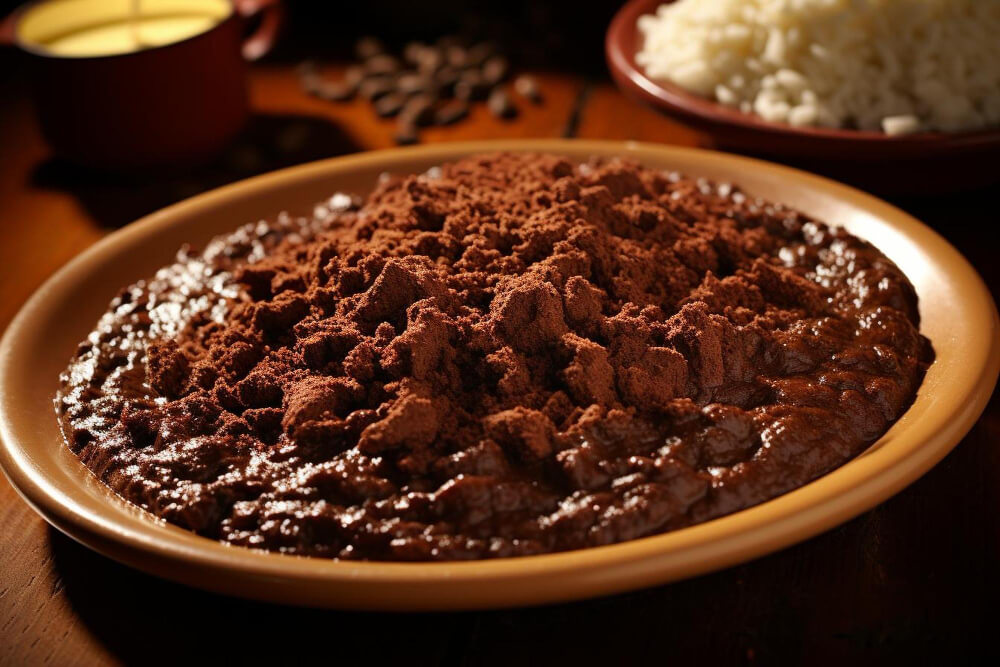What is Champorado?
Champorado is a beloved Filipino chocolate rice porridge that has won the hearts of many. It’s a sweet, comforting dish made with glutinous rice and traditional chocolate tablea. Perfect for rainy mornings or cozy afternoons, this dish evokes nostalgic memories of Filipino breakfasts. Its unique mix of creamy rice and rich chocolate makes it a standout comfort food.
Many recipes include dried fish, known as tuyo, for a perfect balance of sweet and savory. But what makes this dish truly special is its versatility. You can prepare it as a breakfast staple, a snack, or even a dessert. If you’re craving something indulgent yet easy to make, this guide will walk you through the step-by-step process to create the best Champorado. Learn the history, techniques, and variations that make it extraordinary.
For those looking to expand their breakfast recipes, you might also enjoy the fluffy breakfast options like pancakes. Champorado pairs wonderfully with these lighter breakfast dishes.
The History and Cultural Significance of Champorado
The Origin of Champorado
The origins of Champorado date back to the Spanish colonial era. Chocolate, brought to the Philippines by Spanish colonizers, became a key ingredient in local cuisine. Combined with sticky rice, a Filipino staple, Champorado evolved into a dish that symbolizes cultural fusion. It’s believed to have been inspired by the Mexican dish Champurrado, a chocolate-based drink. Over time, Filipinos turned it into the creamy rice porridge we know and love today.
Cultural Importance
Filipinos serve Champorado during family gatherings, making it a dish rich in emotional ties. It’s often enjoyed during the rainy season, warming both the body and the soul. Its cultural significance is akin to how Americans regard hot chocolate on cold winter nights.
Transitioning into a savory-sweet dish, Champorado is frequently paired with tuyo (salted dried fish), creating a balance of flavors that’s both comforting and indulgent. For more insights into Filipino cooking, check out this overview of Filipino cuisine.
The Ingredients That Make Champorado Special
Classic Champorado Ingredients
Here’s a breakdown of what you’ll need to make this dish:
- Glutinous rice: Essential for the creamy texture.
- Tablea: Filipino chocolate tablets rich in cacao, often available in local markets. Alternatively, cocoa powder works as a substitute.
- Sugar: Adjust based on your sweetness preference.
- Milk: Evaporated or condensed milk adds richness to the dish.
Optional Add-Ons and Toppings

Elevate your Champorado with:
- Fresh fruits like bananas or mangoes.
- A drizzle of caramel or peanut butter.
- Savory pairings like crispy bacon or salted fish.
Transition words make recipes easier to follow. When preparing this dish, think of it as creating a balance between classic ingredients and creative twists.
If you’re looking for other breakfast recipes, this dish complements hearty choices like burritos or omelets.
Step-by-Step Cooking Process
Cooking Champorado is simple if you follow these steps:
- Prepare the rice: Wash and rinse glutinous rice until the water runs clear.
- Cook the rice: Combine the rice and water in a medium pot. Bring to a boil, then simmer until the rice becomes soft and creamy.
- Melt the chocolate: Dissolve tablea in a small amount of hot water, stirring until smooth.
- Combine ingredients: Add the melted chocolate and sugar to the pot. Stir constantly to ensure a smooth texture.
- Serve: Top with milk and your chosen add-ons for a delightful finish.
Exploring Variations and FAQs
Delicious Variations of Champorado
One of the best things about Champorado is its versatility. Here are some exciting ways to add variety to this classic dish:
- Peanut Butter Champorado
- Add a swirl of peanut butter for a nutty flavor.
- Pair it with sliced bananas for a protein-rich twist.
- Ube Champorado
- Replace or combine tablea with ube (purple yam) for a vibrant color and sweet, earthy taste.
- This variation is popular during festive occasions.
- Coffee-Infused Champorado
- For coffee lovers, add a shot of espresso or instant coffee powder.
- It balances the sweetness and gives an extra kick.
- Vegan Champorado
- Use coconut milk instead of regular milk.
- Opt for vegan chocolate or dark cocoa powder.
- Savory Champorado
- Skip the sugar and chocolate, and instead, mix in shredded chicken or pork. This creates a savory porridge suitable for lunch or dinner.
Each variation brings its unique flavor, but the comforting essence of Champorado remains. If you’re exploring other Filipino favorites, try this quick and easy Pancit Canton recipe for a complete Pinoy meal experience.
What makes Champorado different from Champurrado?
Filipinos prepare Champorado as a rice porridge using glutinous rice and tablea chocolate, while Mexicans make Champurrado as a drink with masa harina (corn dough) and cacao.
Can I use regular rice instead of glutinous rice?
You can use regular rice, but it won’t create the same creamy texture. Glutinous rice delivers the signature stickiness that defines Champorado.
What are some traditional pairings with Champorado?
Many Filipinos pair Champorado with tuyo (salted dried fish) to create a sweet and savory balance. Others enjoy it alongside slices of buttered toast for extra richness.
Can I serve Champorado cold?
You can serve Champorado cold for a refreshing treat. Simply refrigerate leftovers and top them with milk before serving.
What type of chocolate works best for Champorado?
Most traditional recipes use tablea chocolate, but unsweetened cocoa powder or dark chocolate works as excellent substitutes.
Kitchen Equipment Needed
Here’s what you’ll need to prepare Champorado like a pro:
- Medium pot: For cooking the rice.
- Wooden spoon: To stir the porridge continuously.
- Measuring cups: Ensures accuracy for rice and water proportions.
- Grater or knife: If using block chocolate instead of tablea.
- Serving bowls: To present the dish beautifully.
Having the right tools makes the process smoother and ensures consistent results. You can also use these tools for other Filipino recipes, such as Arroz Caldo, another comforting rice dish.
Tips for Perfect and Creative Serving Ideas
Expert Tips for Perfect Champorado
- Rinse the Rice Thoroughly
Wash the glutinous rice until the water runs clear. This step removes excess starch and prevents the porridge from becoming overly sticky. - Use Fresh Tablea or Quality Cocoa Powder
Opt for high-quality tablea to achieve the authentic rich flavor. If unavailable, unsweetened cocoa powder or dark chocolate chips will work just as well. - Stir Constantly
Stirring ensures that the rice doesn’t stick to the bottom of the pot. It also helps distribute the chocolate evenly, creating a silky consistency. - Adjust Sweetness Gradually
Start with a small amount of sugar, then add more as needed. This approach lets you balance the sweetness based on your taste preferences. - Serve Immediately
Champorado thickens as it cools, so it’s best served hot and fresh. If reheating, add a splash of milk or water to loosen its consistency.
For more breakfast ideas with similar comforting vibes, explore these quick and easy oatmeal recipes for inspiration.
Creative Serving Suggestions

- Dessert Style
- Serve cold with a scoop of vanilla ice cream or whipped cream for a decadent dessert.
- Breakfast Bowl
- Add fruits like sliced bananas, strawberries, or even granola for a refreshing breakfast twist.
- Tuyo Pairing
- Sprinkle flaked tuyo (salted dried fish) over your Champorado for the classic sweet-savory combination.
- Layered Jar Champorado
- Create Instagram-worthy dessert jars by layering Champorado, whipped cream, and crushed graham crackers.
- Fusion Ideas
- Incorporate melted peanut butter, Nutella, or coffee for a fusion-inspired dish that excites the palate.
For other dishes to serve alongside this, check out Filipino comfort food recipes that complement Champorado perfectly.
How to Store and Reheat Champorado
Proper storage ensures that your leftover Champorado stays fresh and flavorful:
- Storage Tips
- Let the Champorado cool to room temperature before transferring it to an airtight container.
- Store in the refrigerator for up to 3 days.
- Reheating Tips
- Heat gently in a pot or microwave, adding a splash of water or milk to restore the creamy texture.
- Stir well during reheating to ensure even consistency.
Nutritional Facts (Per Serving)
Here’s an approximate nutritional breakdown for a serving of Champorado (1 cup):
- Calories: 320 kcal
- Protein: 4g
- Carbohydrates: 60g
- Fat: 7g
- Sugar: 20g
- Fiber: 2g
This dish is a comforting indulgence, perfect for satisfying sweet cravings or starting your day with a warm bowl of chocolate goodness.
Champorado is more than just a dish; it’s a nostalgic experience that ties you to the rich heritage of Filipino cuisine. Whether you enjoy it the traditional way with tuyo, or add creative twists like ube or peanut butter, it’s a dish that offers versatility and comfort. With a few simple ingredients and some care, you can recreate this classic in your kitchen and share it with loved ones.
If you’re looking for more Filipino culinary adventures, don’t miss out on Filipino dessert favorites or explore savory options like Chicken Adobo to expand your repertoire.

